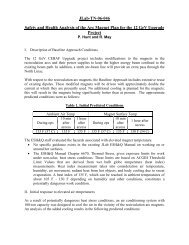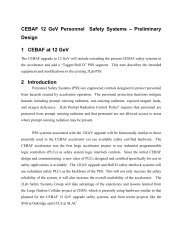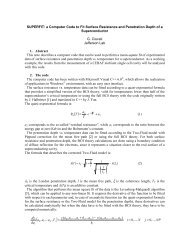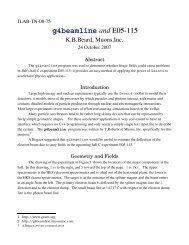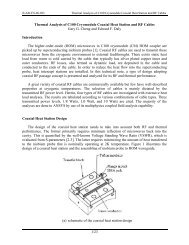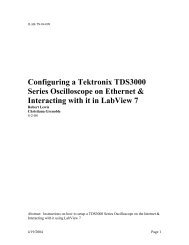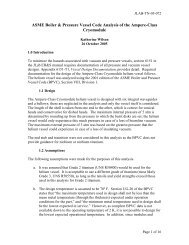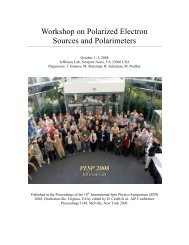Direct Digital Down/Up Conversion for RF Control of Accelerating ...
Direct Digital Down/Up Conversion for RF Control of Accelerating ...
Direct Digital Down/Up Conversion for RF Control of Accelerating ...
Create successful ePaper yourself
Turn your PDF publications into a flip-book with our unique Google optimized e-Paper software.
<strong>Direct</strong> <strong>Digital</strong> <strong>Down</strong>/<strong>Up</strong> <strong>Conversion</strong><br />
<strong>for</strong> <strong>RF</strong> <strong>Control</strong> <strong>of</strong> <strong>Accelerating</strong> Cavities<br />
C. Hovater, T. Allison, R. Bachimanchi, J. Musson and T. Plawski<br />
Introduction<br />
As digital receiver technology has matured, direct digital down/up conversion <strong>for</strong> <strong>RF</strong> control<br />
<strong>of</strong> accelerating and beam conditioning cavities is now practical above 100 MHz. The typical <strong>RF</strong><br />
transceiver utilizes a heterodyne scheme, generating an intermediate frequency (typically < 100<br />
MHz) which is then processed by an ADC or generated by a DAC. The suggestion here is to<br />
eliminate the heterodyne stage and go directly into the ADC or out <strong>of</strong> the DAC to the cavity<br />
frequency. Accelerators with accelerating cavity frequencies between 100 MHz and 1 GHz,<br />
especially ones that have multiple frequencies, are good candidates <strong>for</strong> this technology. Two In<br />
particular, are the CEBAF <strong>RF</strong> Separator cavity operating at 499 MHz and the Argonne proposal<br />
<strong>for</strong> the Facility <strong>for</strong> Rare Isotope Beams (FRIB) accelerator. The FRIB project has multiple cavity<br />
frequencies (345, 172.5, 115, and 57.5 MHz) which would require multiple <strong>RF</strong> receivers. The<br />
benefit <strong>of</strong> using DDC is the elimination <strong>of</strong> <strong>RF</strong> transceivers, reducing the cost and simplifying the<br />
<strong>RF</strong> control design. An additional benefit is the elimination <strong>of</strong> drifts and maintenance issues<br />
associated with the <strong>RF</strong> transceiver. This paper discusses the possibility <strong>of</strong> such systems.<br />
<strong>Direct</strong> <strong>Digital</strong> <strong>Conversion</strong>: <strong>Down</strong> and <strong>Up</strong><br />
<strong>Direct</strong> down conversion (DDC) <strong>of</strong> analog to digital converters (ADC) has been around <strong>for</strong><br />
many years and is the basis <strong>for</strong> most modern LL<strong>RF</strong> systems. In these cases they employ an<br />
intermediate frequency (IF) typically below 100 MHz. The reason <strong>for</strong> this is that above 100 MHz<br />
the signal to noise ratio (S/N) <strong>for</strong> the ADC falls <strong>of</strong>f due to the effect clock jitter has on the<br />
conversion process. In accelerators, the S/N ratio determines the achievable cavity field control<br />
per<strong>for</strong>mance. For light sources and electron nuclear physics accelerators where field control<br />
better than 0.5 o and 0.1% is expected, direct conversion may not be acceptable <strong>for</strong> this reason. In<br />
addition the technology to sample above 1 GHz is not practical <strong>for</strong> the reason given.<br />
In the case <strong>of</strong> a DDC system, the ADC is sampled directly and typically at a quadrature (I and<br />
Q) sub-harmonic <strong>of</strong> the <strong>RF</strong> frequency. Figure 1 shows a cartoon <strong>of</strong> a DDC system and a<br />
heterodyne system. The simplest quadrature sampling method is four times the <strong>RF</strong> signal. That is<br />
the sampling across the <strong>RF</strong> is 90 degrees apart. If a frequency to be sampled is 50 MHz then the<br />
sampling frequency is 200 MHz. Most ADCs can’t sample at such a high rate but one can sample<br />
at a sub harmonic frequency using the following rule (Quadrature Sampling rate)/(2n+1). In the<br />
example above <strong>for</strong> n=2 the sampling rate would be 40 MHz. Using the signals quadrature<br />
components allows the control system an efficient method to control cavity field without extra<br />
hardware (extra <strong>RF</strong> components and ADC).<br />
Similarly digital up conversion can be accomplished by sampling a digital to analog converter<br />
(DAC) with a quadrature sub harmonic [1]. DAC’s have been used <strong>for</strong> digital frequency<br />
synthesis <strong>for</strong> many years and are available with outputs up to 500 MHz. The process here is to
again clock the DAC at the quadrature sub-harmonic <strong>of</strong> the required frequency. The quadrature<br />
components are updated at this rate and series <strong>of</strong> harmonics are generated. Using the same<br />
example as above and clocking a DAC at 40 MHz will generate spectral lines at fs/4 = 10 MHz<br />
and then every fs/4 x (2n+1) or 30, 50, 70 MHz and so on. In this case, the signal <strong>of</strong> interest is 50<br />
MHz and by filtering out this frequency we have generated our signal. The same can be done at<br />
higher frequencies up to the limit <strong>of</strong> the DAC.<br />
Figure 1: Block diagram <strong>of</strong> a heterodyne receiver and a direct down conversion receiver.<br />
Receiver Requirements<br />
Receiver requirements are determined by the required field/resonance control and the dynamic<br />
range needed <strong>for</strong> gradient control. Using the FRIB linac as an example the needed cavity phase<br />
and amplitude control is 0.5 o and 0.5% to meet its beam per<strong>for</strong>mance requirements. From this we<br />
can develop a receiver specification <strong>for</strong> S/N. This specification must be maintained across a<br />
gradient dynamic range <strong>of</strong> 10 dB (e.g. 5 to 15 MV/m). In addition we will add some margin <strong>for</strong><br />
error and make the field control requirements 0.25 o and 0.25%, which effectively gives us a 6 dB<br />
error margin beyond the requirement. Looking at amplitude first and using the amplitude<br />
stability specification, the S/N will need to be 52 dB [20 log(0.0025)] across the amplitude<br />
dynamic range. So at the bottom end <strong>of</strong> the dynamic range our ADC must have 62 dB S/N (52 +<br />
10).<br />
Using the existing CEBAF Energy <strong>Up</strong>grade receiver and eliminating the analog down<br />
conversion portion, we can estimate a noise floor and a noise figure at the input <strong>of</strong> the ADC.<br />
Figure 2 shows the front end receiver <strong>for</strong> a DDC.
Figure 2: <strong>Direct</strong> <strong>Down</strong> <strong>Conversion</strong> Receiver<br />
From the required S/N we can make some assumptions. Looking at the ADC input range (0 dBm<br />
to 10 dBm) and the extremely low noise floor (~ -106 dBm), signal strength is not an issue.<br />
There<strong>for</strong>e given the background noise <strong>of</strong> a receiver can maintain an S/N <strong>of</strong> 52 dB over the<br />
dynamic range, we will meet our field control requirement. This effectively falls upon the ADC.<br />
The S/N <strong>of</strong> an ideal ADC is given by the following equation<br />
S / N [6.02N 1.76] [1]<br />
where N is the number <strong>of</strong> bits in the ADC. Using this equation the S/N ratio <strong>for</strong> 12, 14 and 16 bit<br />
ADCs is 74, 85.76, and 98.08 dB respectively. In reality reaching much beyond 80 dB even <strong>for</strong><br />
16 bit ADC communication (> 10 MSPS) is difficult. The effective input noise starts to go<br />
beyond a least significant bit (LSB), <strong>for</strong> ADCs above 14 bits. There<strong>for</strong>e your effective number <strong>of</strong><br />
bits (ENOB) is less than ideal. More realistic S/N ratios <strong>for</strong> these ADCs would be 70, 74, and 78<br />
dB. Other factors must be included into the calculation including linearity and clock jitter. For<br />
the DDC clock jitter is the most serious issue. As the ADC input frequency is increased the S/N<br />
decreases primarily because <strong>of</strong> clock jitter. This can be understood by looking at figure 3 [2].<br />
The voltage variation because <strong>of</strong> the clock jitter is larger <strong>for</strong> higher frequencies. This manifests<br />
itself in S/N degradation. Putting all these affects into a realistic S/N equation gives<br />
2 2 1 2 2V<br />
NOISErms<br />
S / N 20log10 (<br />
ot jrms<br />
)<br />
[2]<br />
N N<br />
3 2 2<br />
2<br />
2<br />
Where o is the analog input frequency (2 f), t jrms is the combined jitter <strong>of</strong> the ADC and clock,<br />
is the average differential nonlinearity (DNL) <strong>of</strong> the ADC in LSBs, V noiserms is the effective input<br />
noise <strong>of</strong> the ADC in LSBs and N is the number <strong>of</strong> ADC bits.
S/N<br />
Figure 3: <strong>Conversion</strong> error as a function <strong>of</strong> clock jitter and analog input frequency [2].<br />
Figures 4, shows a 12 bit ADC’s S/N vs input frequency <strong>for</strong> different clock jitters. For the<br />
ANL FRIB proposal the spoke cavity has the highest operating frequency at 345 MHz. If the<br />
ADC can reach 62 dB S/N <strong>for</strong> this frequency then any lower frequency will be met. From figure<br />
4 we see that at 345 MHz the S/N is approximately 63 dB <strong>for</strong> a clock jitter <strong>of</strong> 300 fs.<br />
75<br />
12 Bit ADC S/N vs Input Frequency<br />
70<br />
65<br />
60<br />
55<br />
100 fs<br />
200 fs<br />
300 fs<br />
50<br />
1.00E+07 1.00E+08 1.00E+09<br />
Frequency (Hz)<br />
Figure 4: 12 Bit ADC, Analog Devices AD9627
In addition the receiver assumptions here are <strong>for</strong> full sampling bandwidth <strong>of</strong> the ADC. A non<br />
trivial amount <strong>of</strong> S/N improvement will be had with processing gain in the logic. Using FRIB as<br />
an example with the <strong>RF</strong> at 345 MHz. The clock frequency needs to be a multiple <strong>of</strong> 345MHz x<br />
4/(2n+1). Using n = 7 gives an even the clock frequency <strong>of</strong> 92 MHz. After separating the signal<br />
into I and Q the rate will be ½ this value or 46 MHz. Our control bandwidth is 100 kHz (i.e. the<br />
bandwidth needed <strong>for</strong> the feedback to control the cavity microphonics). As a rule oversampling<br />
will improve S/N by log(N 1/2 ), where N is the amount over sampling. In the case above, N would<br />
be 46 MHz/100kHz or 460. There<strong>for</strong>e the S/N could theoretically improve by 26 dB. Even if we<br />
only improve the S/N by 10 dB, this puts the S/N an order <strong>of</strong> magnitude higher than required.<br />
Determining the phase requirement <strong>for</strong> the receiver is more subtle. Our control specification is<br />
0.25 o over gradient change <strong>of</strong> 10 dB. To map this into S/N space we need to resolve the<br />
amplitude difference between two angles separated by 0.25 o . In the I (cos) and Q (sin) domain<br />
the worst case is near a 45 degree point where I = Q. Converting to that domain (either sin or<br />
cos) and taking the difference between 45.0 o and 45.25 o gives a S/N <strong>of</strong> 50.2 dB* needed to<br />
resolve either I or Q. Adding our imposed 10 dB <strong>for</strong> dynamic range gives a S/N <strong>of</strong> 60.2 dB<br />
needed <strong>for</strong> phase control. One may also ask what happens near 0 o or 90 o . In this case I or Q is<br />
approximately one and the S/N needed to resolve the angle is approximately 47 dB. So it is<br />
easier to resolve near these angles. Looking at the worst case in phase we can say that receiver<br />
S/N specification is being driven by the amplitude requirement <strong>of</strong> 52 dB.<br />
Transmitter Design<br />
The requirements <strong>for</strong> the transmitter can be relaxed when in comparison to the receiver. The<br />
reason being is that it is in the feed-<strong>for</strong>ward path <strong>of</strong> the control loop and signal errors are small in<br />
comparison to power amplifier contributions. As long as amplifier saturation and other nonlinearity<br />
do not hinder the feedback loop it is a straight <strong>for</strong>ward process to generate the <strong>RF</strong> drive<br />
signal out <strong>of</strong> a single DAC.<br />
<strong>RF</strong> Separator Resonance <strong>Control</strong><br />
The proposed 12 GeV CEBAF <strong>RF</strong> separator resonant control would need to control cavity<br />
resonance to one degree. In this case we do not need to control on amplitude only phase so this<br />
will set up our receiver S/N. The amplitude difference between 45 o and 46 o gives an S/N <strong>of</strong> 38<br />
dB needed to resolve the angle. At 499 MHz the graph in figure 4 shows a 12 bit ADC S/N <strong>of</strong> 60<br />
dB with 300 fs <strong>of</strong> jitter. In this case the angle would be used to activate a valve controlling the<br />
water flow through the separator cavity<br />
FRIB <strong>RF</strong> <strong>Control</strong><br />
The FRIB <strong>RF</strong> system must be able to handle a number <strong>of</strong> cavity frequencies. Table 1 shows the<br />
Cavity frequencies, the ADC clock, and DAC clock <strong>for</strong> such a DDC system [3]. All <strong>RF</strong><br />
frequencies and clock frequencies can be generated from a master reference <strong>of</strong> 276 MHz. In a<br />
traditional <strong>RF</strong> receiver this is a problem considering the number <strong>of</strong> different <strong>RF</strong> boards necessary<br />
*20log[cos(45) – cos(45.25)] = -50.2 dB, this effectively converts the
to accommodate the all <strong>of</strong> the <strong>RF</strong> and Local Oscillator (LO) frequencies. The advantage here is<br />
to make one board with similar ADC’s and DACs where the only difference is the band pass<br />
filter (BPF) in front <strong>of</strong> the ADC or DAC. The digital self excited loop control process developed<br />
<strong>for</strong> the CEBAF 12 GeV upgrade would then be used <strong>for</strong> cavity field control [4].<br />
Table 1<br />
<strong>Down</strong><br />
(2n+1)<br />
<strong>Up</strong><br />
Cavity<br />
conversion<br />
<strong>RF</strong> (MHz)<br />
ADC<br />
Clock<br />
(MHz)<br />
conversion<br />
n Clock Div DAC<br />
Clock<br />
(MHz)<br />
Clock Div<br />
Frequency<br />
5 th<br />
Harmonic<br />
(MHz)<br />
57.5 46 2 6 46 6 57.5<br />
115 92 2 3 92 3 115<br />
172.5 46 7 10 138 2 172.5<br />
345 92 7 5 276 1 345<br />
Prototype Test Results<br />
Using an Altera Stratix FPGA evaluation board with a 12 bit Analog Devices ADC (AD9433)<br />
we were able to resolve phase and amplitude variations at both 499 MHz and 345 MHz. The<br />
evaluation board has dual channel 20 MHz DACs that we used to display the resulting I and Q<br />
signals. An Agilent <strong>RF</strong> signal source was used to generate the <strong>RF</strong> signal and the modulation. In<br />
each case phase and amplitude was modulated at 400 Hz, respectively, using a square wave.<br />
Figure 5 shows a scope trace <strong>of</strong> one degree <strong>of</strong> phase modulation at 499 MHz as detected by the<br />
ADC. The phase modulation is processed in the Altera Stratix FPGA and then output through the<br />
two DACs. The clock frequency in this case was 79.84 MHz (where n = 12). Both the I and Q<br />
are shown and the they are approximately equal or at modulo 45 o .<br />
Figure 5: I and Q DDC result <strong>of</strong> ½ o phase modulation on a 499 MHz carrier frequency. Scale<br />
5mV/div and 1 msec/div.<br />
Similarly Figure 6 shows the result <strong>of</strong> 0.5% amplitude modulation on a 345 MHz carrier<br />
frequency as detected by the ADC. The clock frequency in this case was 92 MHz (where n = 7).
Figure 6: I and Q DDC result <strong>of</strong> 0.5% amplitude modulation on a 345 MHz carrier frequency.<br />
Scale 5mV/div and 1 msec/div.<br />
Summary<br />
We have presented a proposal <strong>for</strong> <strong>Direct</strong> <strong>RF</strong> <strong>Down</strong> conversion which eliminates a stage (<strong>RF</strong><br />
board) <strong>for</strong> both the <strong>RF</strong> Separator Resonance control and <strong>RF</strong> control <strong>for</strong> ANL/FRIB proposal. The<br />
stumbling block <strong>for</strong> any DDC is the degradation in S/N as the <strong>RF</strong> frequency increases. For both<br />
projects it has been shown that using available technology a system can be built that meets<br />
requirements <strong>for</strong> resonance and field control using DDC. Eliminating a series <strong>of</strong> <strong>RF</strong> boards<br />
where each would be slightly different, simplifies the <strong>RF</strong> system making it easier to maintain. In<br />
addition <strong>for</strong> large scale installations (>20 systems) such as FRIB, the elimination <strong>of</strong> the <strong>RF</strong> frontend<br />
could save the project upwards <strong>of</strong> $500,000, over the design and construction <strong>of</strong> the project.<br />
References<br />
[1] L. Doolittle, “Plan <strong>for</strong> a 50 MHz Analog Output Channel”,<br />
http://recycle.lbl.gov/~ldoolitt/plan50MHz/<br />
[2] R. Reeder et al,”Analog-to-<strong>Digital</strong> Converter Clock Optimization: A Test Engineering<br />
Perspective”, Analog Dialogue Volume 42 Number 1<br />
[3] Conversations with Jean Delayen.<br />
[4] C. Hovater, et al. “A <strong>Digital</strong> Self Excited Loop <strong>for</strong> <strong>Accelerating</strong> Cavity Field <strong>Control</strong>”,<br />
Proceedings <strong>of</strong> the 2007 Particle Accelerator Conference, Albuquerque, NM



